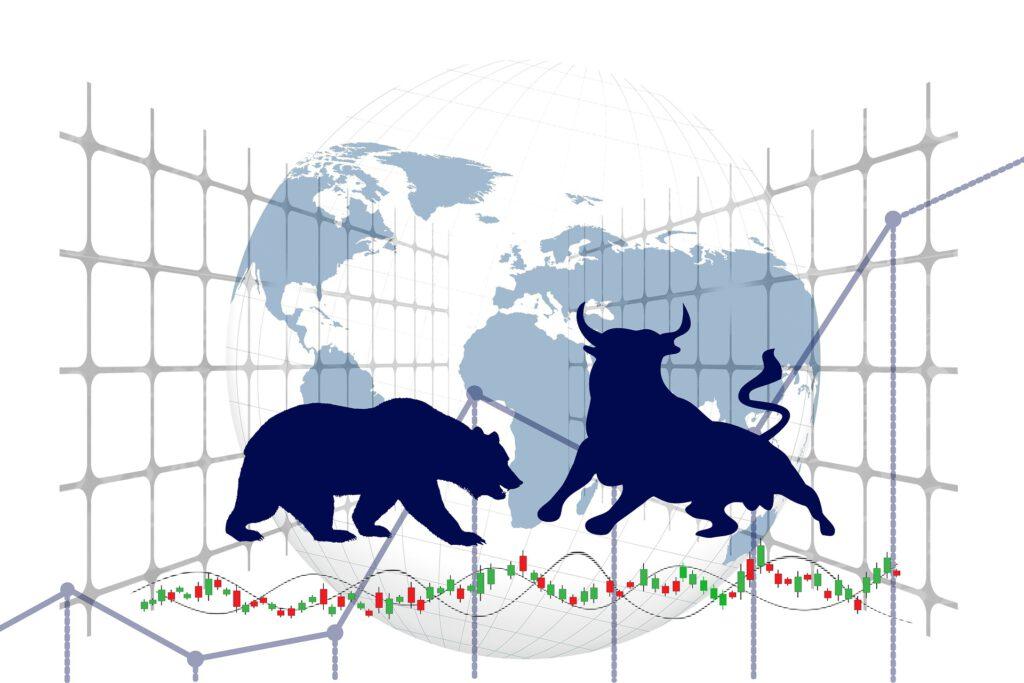
KGV, KBV, KUV – Der Kennzahlenwahnsinn
Inhalt Puh, Börse ist doch nicht „e wie einfach“ Das KGV, KBV, KUV und wie die ganzen Kennzahlen heißen, ist für jeden Börsenneuling

After there was already a contribution to the bull market last week, today we have the counterpart, the bear market. Every investor should also be familiar with the bear market, because if you are on the stock market long enough, you will inevitably experience a bear market. This is the case because, like the bull market, it is part of the natural cycle of the stock market. A bear market occurs when stocks fall by at least 20% over an extended period of time. The most famous case occurred during the Great Depression. More recent examples are the dot-com crash of 2000 to 2001 and the global financial crisis of 2007 to 2008.

As defined by economists and investors, a bear market occurs when stock prices fall 20% or more from their recent peak. Declines of this magnitude are due to recessions, rising interest rates, and poor earnings. The vast majority of stock prices fall, and investor sentiment is usually very negative.
A bear market can last from a few months to years. Based on the S&P 500 Index, a bear market lasts on average 289 days or about 9.6 months. The average decline is 36%.
Like the bull market, the bear market can generally be divided into four phases, which usually occur in the following order:
In this phase, shareholders sell shares in order to profit from a new high. Investor sentiment is usually still very optimistic.
This phase occurs when investor sentiment deteriorates due to negative news. Corporate sales and sales growth may slow or even turn negative. Bad economic news, exacerbated by other factors, causes shareholders to sell more shares. Demand for additional capital may reinforce the downward trend.
Finally, prices are so low that speculators are starting to buy shares, which is pushing prices up. Stock prices may still continue to fall as retail and institutional investors remain quiet and may even sell more shares. However, good economic news may cause selling to slow and buyers to return to the market. Stock prices are often volatile during this phase, meaning regular gains are often followed by declines.
Bull markets follow bear markets. Investors expect sales and profits to rise in the future. The combination of low share prices and the expectation of better economic times prompts buyers to re-enter the market.

A correction is when share prices fall by at least 10% but less than 19.9%. Since 1928, there have been a total of 33 corrections. Corrections can turn into bear markets, but many do not. In addition, corrections are often good entry points for investors, as stock prices recover and rise again relatively quickly.
Bear markets arise due to negative expectations regarding future earnings and cash flows. At the end of a growth cycle, companies struggle to increase sales and profits. Investors' expectations are not met. Consequently, they sell their stock holdings. Other shareholders watching share prices try to limit their losses and also sell, resulting in a downward trend.
Risk aversion and bearish sentiment prevent share prices from recovering. Eventually, however, share prices bottom out and an upward market begins again.
The reasons for a bear market vary. However, as a rule, a weak or slowing economy puts pressure on revenues and profits, which leads to stock sales. In addition, the economy may enter a recession, which is characterized by a decline in gross domestic product (GDP) for two consecutive quarters. However, a recession and a bear market do not always occur simultaneously. We have already written a post on the topic of recession, so if you want to learn even more, check out here.
Other factors that influence a bear market are pandemics and wars. For example, the COVID-19 pandemic triggered widespread consumer fears and regulatory actions by governments, which severely impacted economic activity. Similarly, the Russia-Ukraine war affected the global economy by boosting inflation and reducing the supply of grain, oil, and natural gas, leading to a bear market. Also, in response to high inflation or high unemployment, corrections or a bear market can occur.
By definition, a bear market is a decline in the stock market of 20% or more. These are difficult to deal with, but are a normal part of the investment process. Any investor who has been around the stock market long enough will experience such a period of recession. The unrealized losses are painful and often make investors nervous. But bull markets eventually come back. However, investors who focus on speculative and riskier stocks often wait many years to recoup their losses. One possible solution to this could be dividend stocks, as they can often provide a stable passive income even in times of crisis. If you want to learn even more about the pros and cons of dividend stocks, take a look at here .
If you would like to discover more dividend stocks or ETFs, you are welcome to use our Dividend App. myDividends24 use. Here you get access to over 2000 stocks and ETFs and can even create a portfolio and add the stocks you want. Here you can find more details for this. Download now free of charge and test it for 7 days.

Inhalt Puh, Börse ist doch nicht „e wie einfach“ Das KGV, KBV, KUV und wie die ganzen Kennzahlen heißen, ist für jeden Börsenneuling

Inhalt ist eine Anlagestrategie, bei der Anleger Aktien von Unternehmen kaufen, die regelmäßige Dividendenzahlungen ausschütten. Das Ziel dieser Strategie ist es, ein regelmäßiges

Inhalt Viele Anleger fragen sich ständig, warum Aktien fallen, nachdem die Ergebnisberichte der Unternehmen veröffentlicht wurden, besonders, wenn die Entwicklung laut des Berichts
© 2023 mydividends24.de